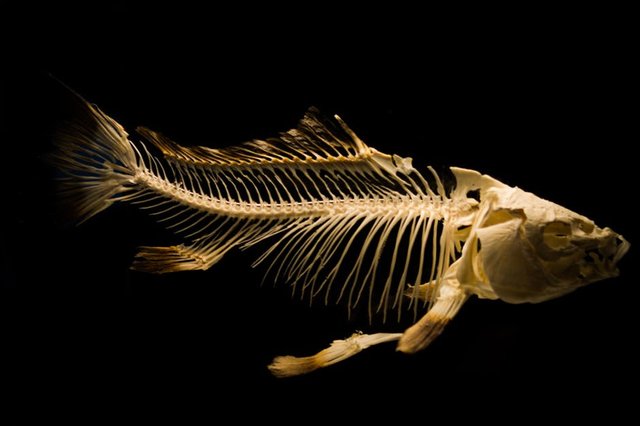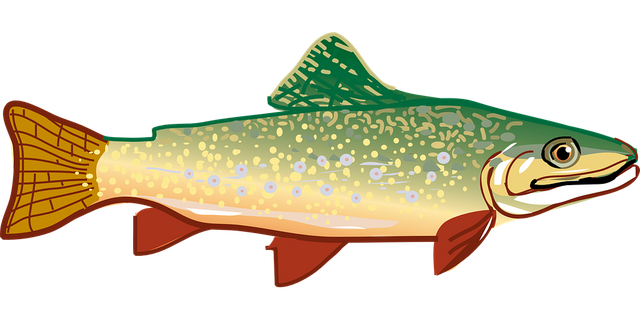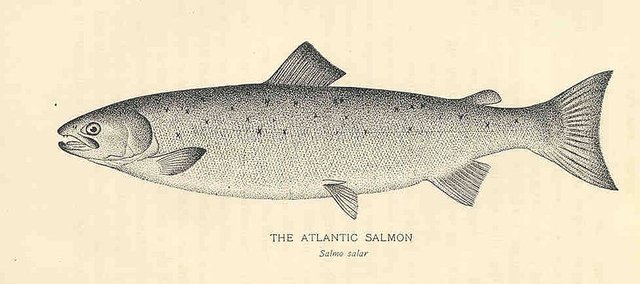Fish Nutrition -Knowing about Nutritional Pathology

Image of A Fish Bone (CC0, No attribution required]: Pexels
Hello everyone - welcome to my new edition of my blog post.
In the wild, nutritional diseases are uncommon. Drought or pollution may limit food availability, and particular phenomena such as the failure of oceanic currents may, you heard it correctly, on some occasion, result in a collapse of planktonic growth and consequent starvation of their predators. Generally, however, wild fish have full opportunity, in their natural environment. To acquire reasonable levels of all their nutritional requirements for survival. This does not mean that, in the normal life cycle of the animal, particularly in temperate zones, seasonal temperature effects, or cyclical changes associated with reproduction, will not produce secondary clinical and histopathological signs of inanition of starvation.
The inanition of the Atlantic salmon Kelt in winter, after spawning-a fish bearing little resemblance to the magnificent fresh run salmon-is an obvious example of the effects of hormonally induced starvation. Dietary provision for farmed fishes may take the form of a complete diet, incorporating the entire nutrient requirement, at appropriate levels for each component.
Alternatively, in the case pond fish, particularly is developing countries in the tropics, provision of a supplementary diet serves to enhance the growth rate of fish, which are expected to obtain at least a proportion of their nutritional complement from the natural productivity of their ponds. These ponds will normally have been fertilized to increase their primary production.
It is normally difficult, under farm conditions, to define nutritional diseases in outright terms, because it is scarce for a single deficiency of one essential nutrient to exist. Nutritionally consist of diets often render fish more susceptible to infectious conditions. These are more clinically obvious and may make the underlying nutritional basis for the condition extremely difficult to define. Of course deficiency of a necessary component is only one aspect of nutritional disease, which has been defined as the deficiency, excess, or improper balance of the components present in a fish diet.
Properly the definition should also include the presence of noxious or toxic components within the food, or endogenous anti-nutrient factors, a problem which has become increasingly significant as intensive aquaculture has developed.
It is only by detailed experimental studies of single-deficiency conditions for each species that is true understanding of nutritional pathologies of fishes can be obtained. In experimental single deficiency conditions, which is describe as a wide range of specific and often pathognomonic signs has been demonstrated to the clinical situation, however, a more general syndrome, often with in appetence, darkening skin color, and poor growth as the only obvious clinical features, is more common.

A Image of a rainbow trout (License: CCo - No attribution required ]: Pixabay
Artificial diets intended as complete sources of nutrients, when produced by a major manufacturer, are usually of high quality. It is only rarely that a particular batch will be responsible for a problem. However, when home mixing of wet diets or trash fish feeding is practiced, the possibility of a deficiency or imbalance syndrome is much higher. Even the high quality commercially compounded diet, however, is susceptible to degeneration during storage. This is particularly likely if storage is under conditions or high temperature or humidity.
Principles of Nutritional Pathology
Starvation may be due to complete deprivation of food, to inadequate feeding levels of a diet which in itself is completely satisfactory, or to behavioral, physiological, or mechanical prevention of food intake.
Complete deprivation may occur if fish are accidentally left in a facility inadequate feeding levels may be associated with bad husbandry, or, in the case of stocked sport fisheries, overstocking may be responsible. Behavioral starvation is the term used to describe the condition often found when attempts are made to rear larval fishes on artificial diets, in which the larvae do not recognize or accept the diet because of inadequate presentation, texture, or taste. Non-feeding larvae or fry may, by catabolizing structural nutrients, survive for a considerable time, although eventually they will appear dark and the head will usually be disproportionately large.
When larvae, or other fast-growing fish such as salmon molts, are starved, they eventually reach a stage at which the degree of body damage induced by the catabolic breakdown is such that, even when normal nutrition is resumed, they cannot recover, this stage, beyond which they cannot be restored, is known as the point of no return (PNR). Larval fish which pass this stage can, however, survive for a considerable time before they inevitably succumb.
The process of physiological starvation is characterized, as might be expected, by loss of weight and change in morphology. Thus affected fish become thinner and the head becomes relatively larger in proportion. The skin colour becomes very dark and eventually the fish lose appetite. At necropsy, there is usually pallor, associated with anemia, and no abdominal lipid is present. The liver is normally shrunken with sharp edges, and where pylori or intestinal ceca are present, they are upstanding and, because they have no visceral fat around them, are very obvious.
Histologically the principal feature, apart from lack of lipid tissue, is the distinctive granular degeneration of the skeletal muscle fibers, with central migration of sarcolemma nuclei. They are predominantly pale staining and have their sarcoplasm condensed into strands and granular deposit in a stroma of clear fluid. The digestive tract is condensed with an apparent increased proportion of collagenous, fibroblastic, and nuclear elements. The hemopoietic tissue is dark and condensed, but a distinctive feature is the increased size of the melanomacrophage centers of spleen and kidney, with large deposits of lipofuscin within them, as well as an increase in the melanin content.

An Image of the atlantic salmon (License: CC-BY-SA, Authors: Dean Sage, C. H . Townsend ]: Wikimedia
A particularly significant feature of the melanomacrophage centers of starved fish is the high level of hemosiderin sequestered there, indicating the premium placed on retaining iron complexes within the body even in extreme farmed fish, more than any other cultured animals, manifest the classical features of Selye’s stress theory. However, it is Brett’s definition of stress in fish that probably fits the situation observed in most husbandry situations.
He describes stress as ‘’a stage produced by an environmental or other factor which extends the adaptive responses of an animal beyond the normal range or which disturbs the normal operation to such to a point that the chances of survival are notably reduced.’’ In fish husbandry, such factors, associated with density, environmental provision, or other husbandry features, are always present.
The primary function of the farmer is to attempt to maintain a system whereby the various components which are capable of acting as stressors are at the lowest possible level compatible with economic success. This has significant implications for growth and feed conversion as well as vulnerability to infection. Stress induces tissue catabolism and energy required for such degradation and resynthesis is not otherwise available for growth. A number of the stressors which can play a role in determining the levels of nonspecific stress in fish are related to food and feeding. As well as frankly inadequate deficient diets, other factors such as irregular feeding, presentation of feed in an unsuitable form, and buildup of waste food detritus can contribute to the sum total of pressures on the adaptive capacity of the animals.
References
Alhazzaa R, Bridle A, Mori T, Barden A, Nichols P, et al. (2013) Echium oil is better than rapeseed oil in improving the response of barramundi to a disease challenge. Food Chem 141:1424-1432.
Boyd C, Tucker C, McNevin A, Bostick K, Clay J (2007) Indicators of resource use efficiency and environmental performance in fish and crustacean aquaculture. Rev Fish Sci 15:327-360.
Christopher D. Golden, Katherine L. Seto, Madan M. Dey, Oai L. Chen, Jessica A. Gephart, Samuel S. Myers, Matthew Smith, Bapu Vaitla and Edward H. Allison, Does Aquaculture Support the Needs of Nutritionally Vulnerable Nations?, Frontiers in Marine Science, 4, (2017).
Katz, D.P., et al. The use of an intravenous fish oil emulsion enriched with omega-3 fatty acids in patients with cystic fibrosis. Nutrition, Vol. 12, May 1996, pp. 334-39
Turchini G, Torstensen B, Ng W (2009) Fish oil replacement in finfish nutrition. Rev Aqua 1:10-57.
Image Sources
All images are from pexels, pixabay and wikimedia licensed under creative commons and eligible for commercial use.
Thanks for reading.
Source
Plagiarism is the copying & pasting of others work without giving credit to the original author or artist. Plagiarized posts are considered spam.
Spam is discouraged by the community, and may result in action from the cheetah bot.
More information and tips on sharing content.
If you believe this comment is in error, please contact us in #disputes on Discord
Congratulations @moabdul123! You received a personal award!
Click here to view your Board
Congratulations @moabdul123! You received a personal award!
You can view your badges on your Steem Board and compare to others on the Steem Ranking
Vote for @Steemitboard as a witness to get one more award and increased upvotes!